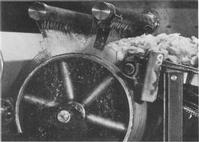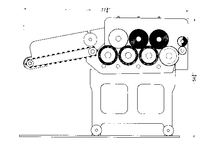


Chapter 5
I 1788 - State Of The Art In Textile Technology
II Australian Textiles - The Early Days
III Australian Textiles - The 20th Century
i Technology and Development
ii Australian Wool Textile Research
IV Australian Textiles - To Date
V Acknowledgements
References
Index
Search
Help
Contact us

Australian Wool Textile Research (continued)
The speed and gentleness with which the wool moved through the bowls was critical to the character of the scoured product. The higher the speed, the more fibre entanglement occurred, and this presented considerable problems in later processing. Not only was it more difficult to open the wool during carding, but the more entangled the fibres were, the greater was the incidence of fibre breakage and damage, resulting in considerable loss from the card and comb in the form of noil.This then at that time was recognized as the major problem in commercial scouring -how to produce scoured wool, as clean as possible, with the minimum of fibre entanglement, yet maintain a maximum throughput.
Efforts had already been made in Australian industry to develop methods of scouring wool using organic solvents. One of these techniques was taken over by CSIRO, and developed to the commercial stage.[14] This system was also simple. Instead of moving through bowls, wool was moved by a travelling conveyor under jets of organic solvent (white spirit). There were two stages of jetting with solvent, followed by two stages of jetting with water. The water jets displaced the solvent from the wool, and dissolved the residual suint (perspiration salts), which was insoluble in white spirit. The sludge from the first bowl was run through a centrifuge, separating the solvent from the grease, allowing the solvent to be re-used. This scouring system gave less disturbance of the wool, resulting in lower entanglement. Comparative trials showed that about one-fifth less noil (waste in topmaking) came from solvent-scoured wool as compared with wool scoured conventionally.
The process was eventually adopted by G. H. Michell and Sons in Adelaide. The capital cost for such a plant and the potential of fire (solvent vapour was not recovered), however, proved a major deterrence to more widespread adoption, and attention turned towards the development of a gentler action, aqueous scouring machine. This eventually spawned in the early 1960s the aqueous jet scour[15] (Fig. 14) in which again the wool was transported under jets of liquor -this time water containing selected, newly introduced non-ionic detergents -by a conveyor and perforated-drum arrangement (Fig. 15). Several commercial installations of this development were made throughout the world by Wessberg & Tulander, a Sydney company, and many of the principles aimed at achieving reduced fibre entanglement were incorporated by other manufacturers in scouring machines of more traditional design.


On the woollen system of processing, scouring is followed by carbonising (Fig. 16) to remove seed and burr. In the early 1950s the local industry was using very drastic conditions of treatment with sulphuric acid to remove the vegetable matter, resulting in considerable fibre damage. In 1952, the Biochemistry Unit in Melbourne set out to improve this situation, and the research resulted in a practical method for reducing acid damage to the wool which was widely applied in industry, firstly in Australia and then overseas. The method[16] made use of detergents which reduced the penetration of acid into the wool, but had no effect on acid absorption by the vegetable.

Organisations in Australian Science at Work - CSIRO Division of Industrial Chemistry; CSIRO Division of Textile Industry; G. H. Michell and Sons, Adelaide; Wessburg & Tulander, Sydney
 |
Australian Academy of Technological Sciences and Engineering |  |
© 1988 Print Edition pages 278 - 280, Online Edition 2000
Published by Australian Science and Technology Heritage Centre, using the Web Academic Resource Publisher
http://www.austehc.unimelb.edu.au/tia/287.html